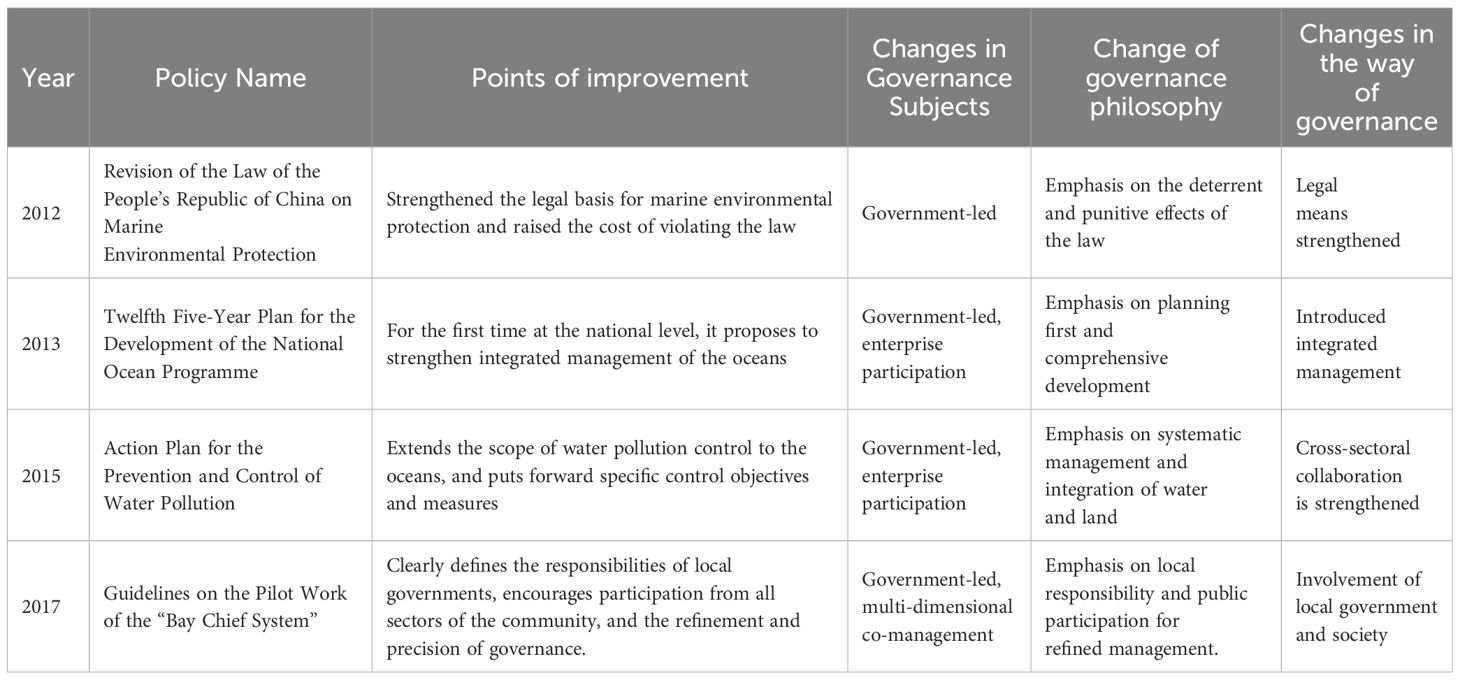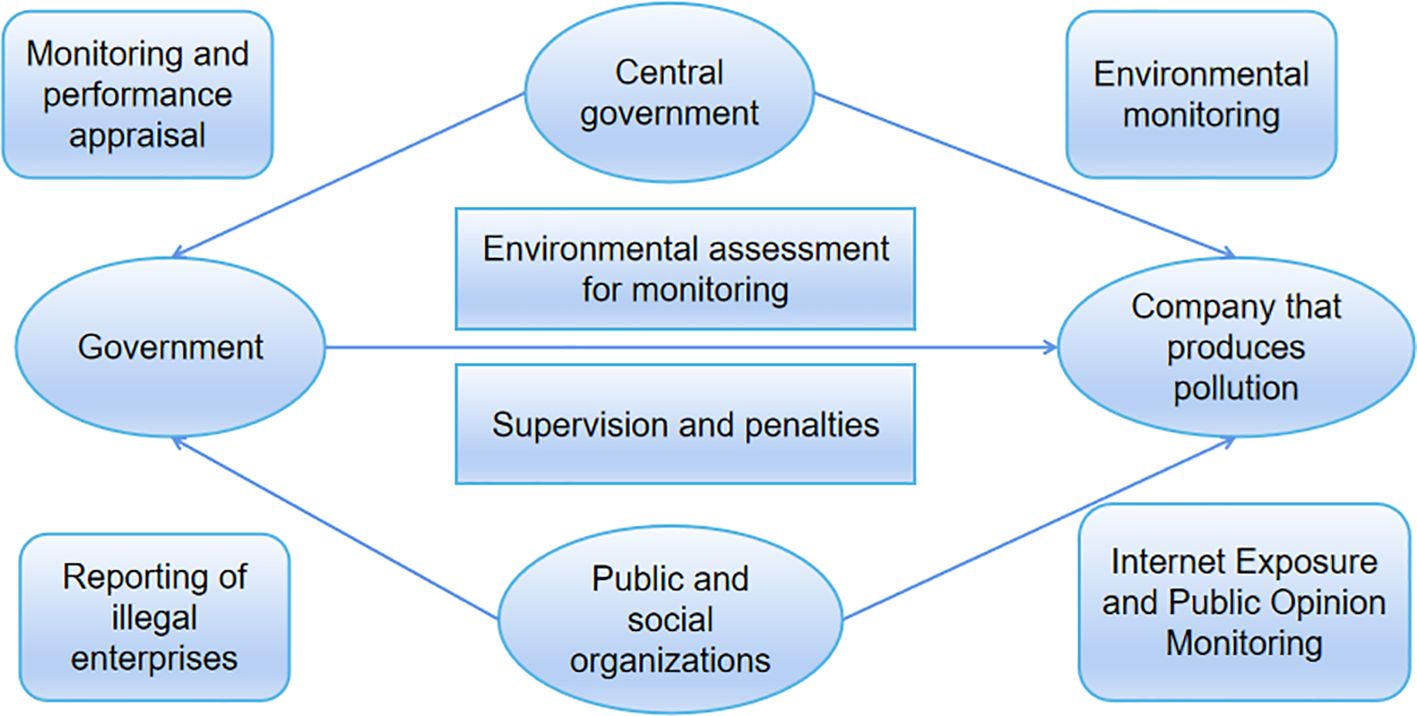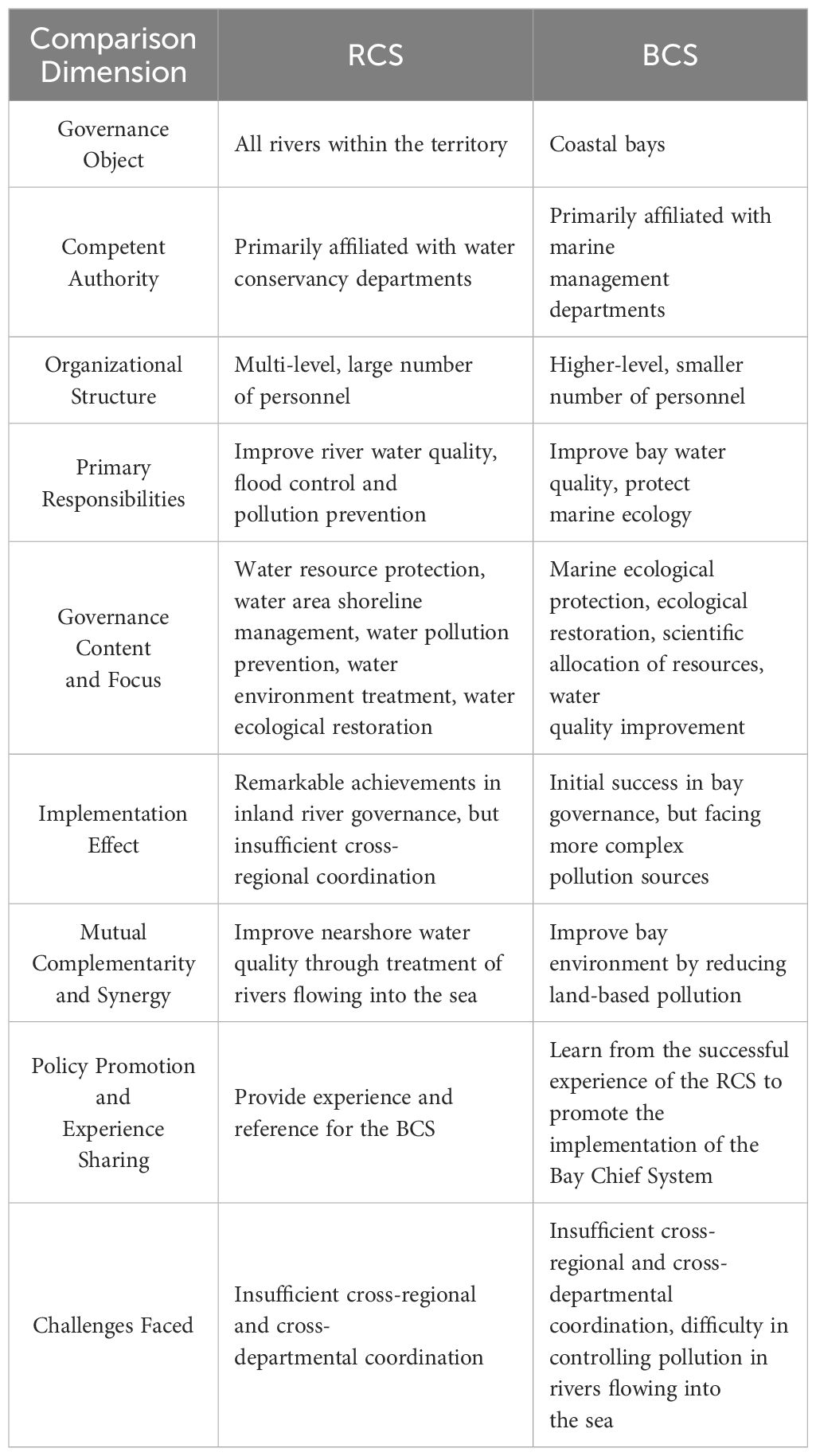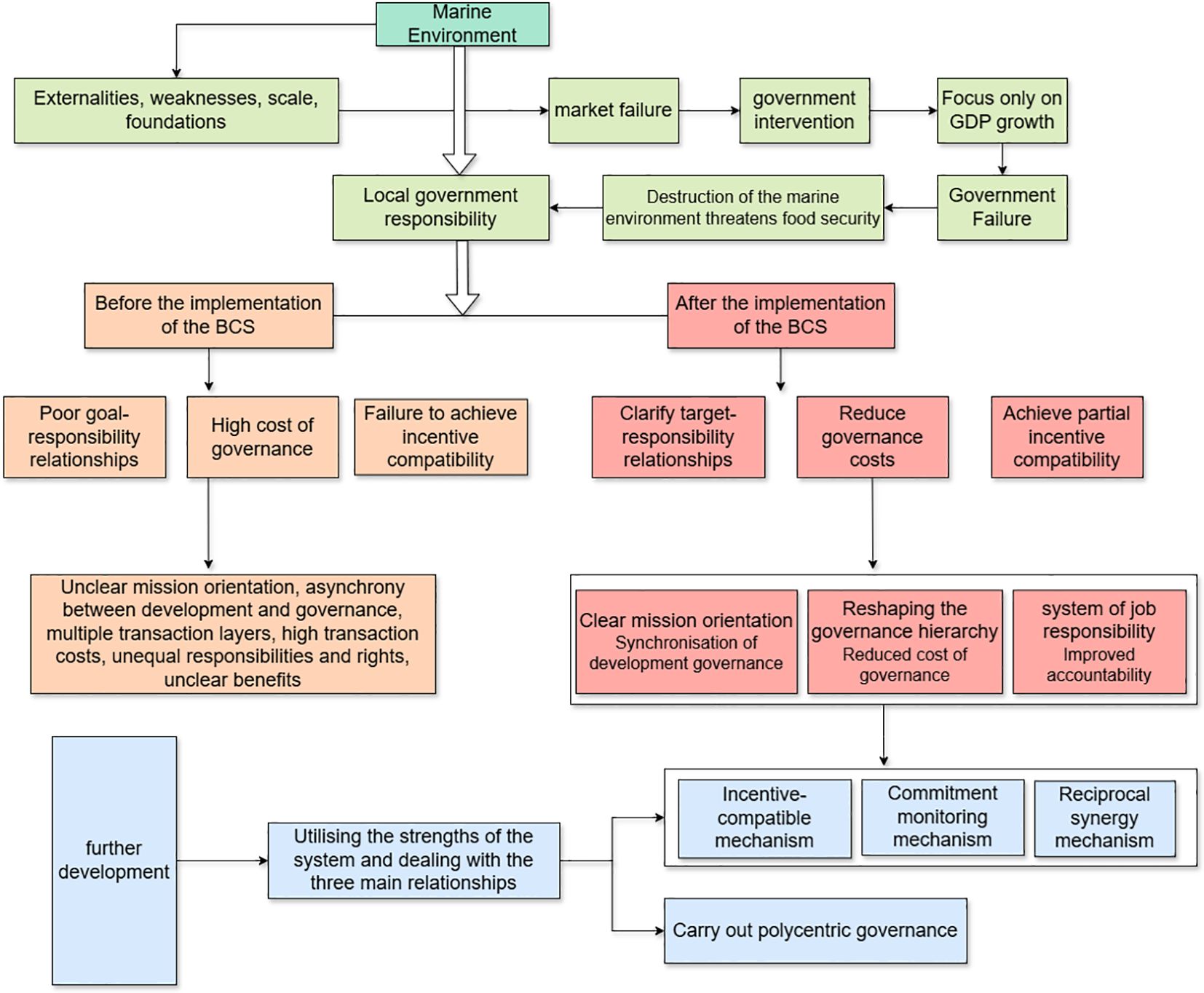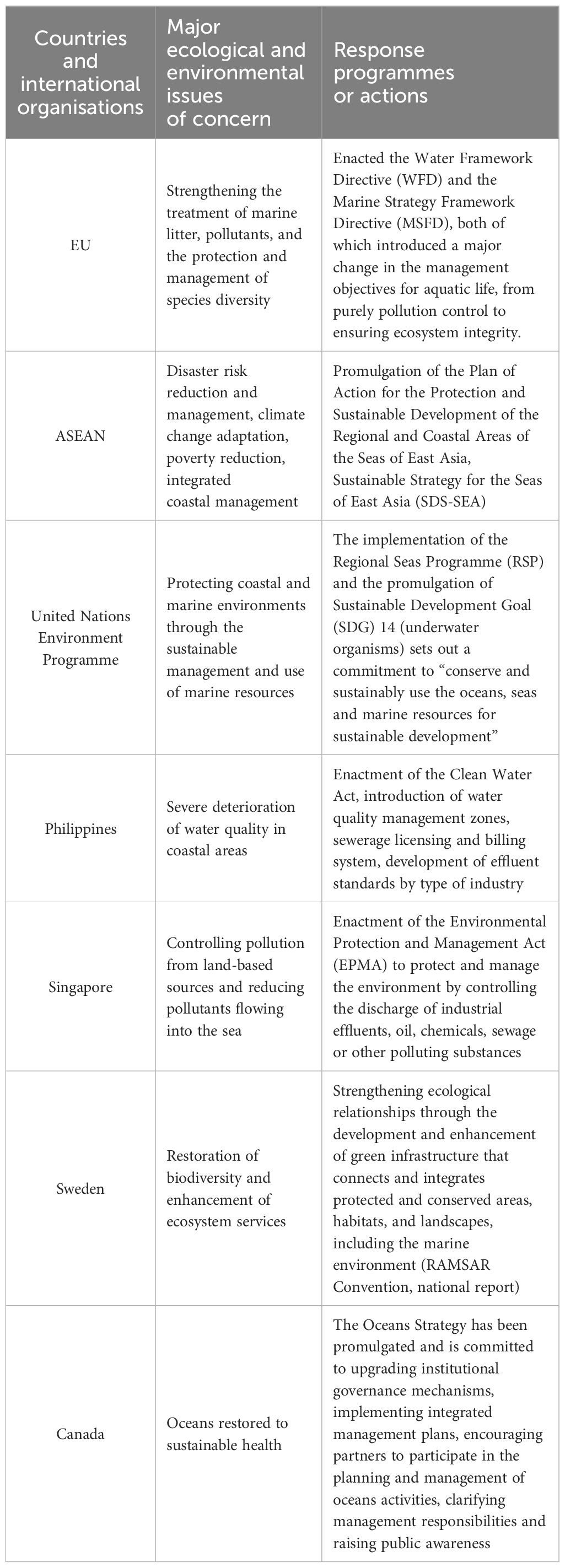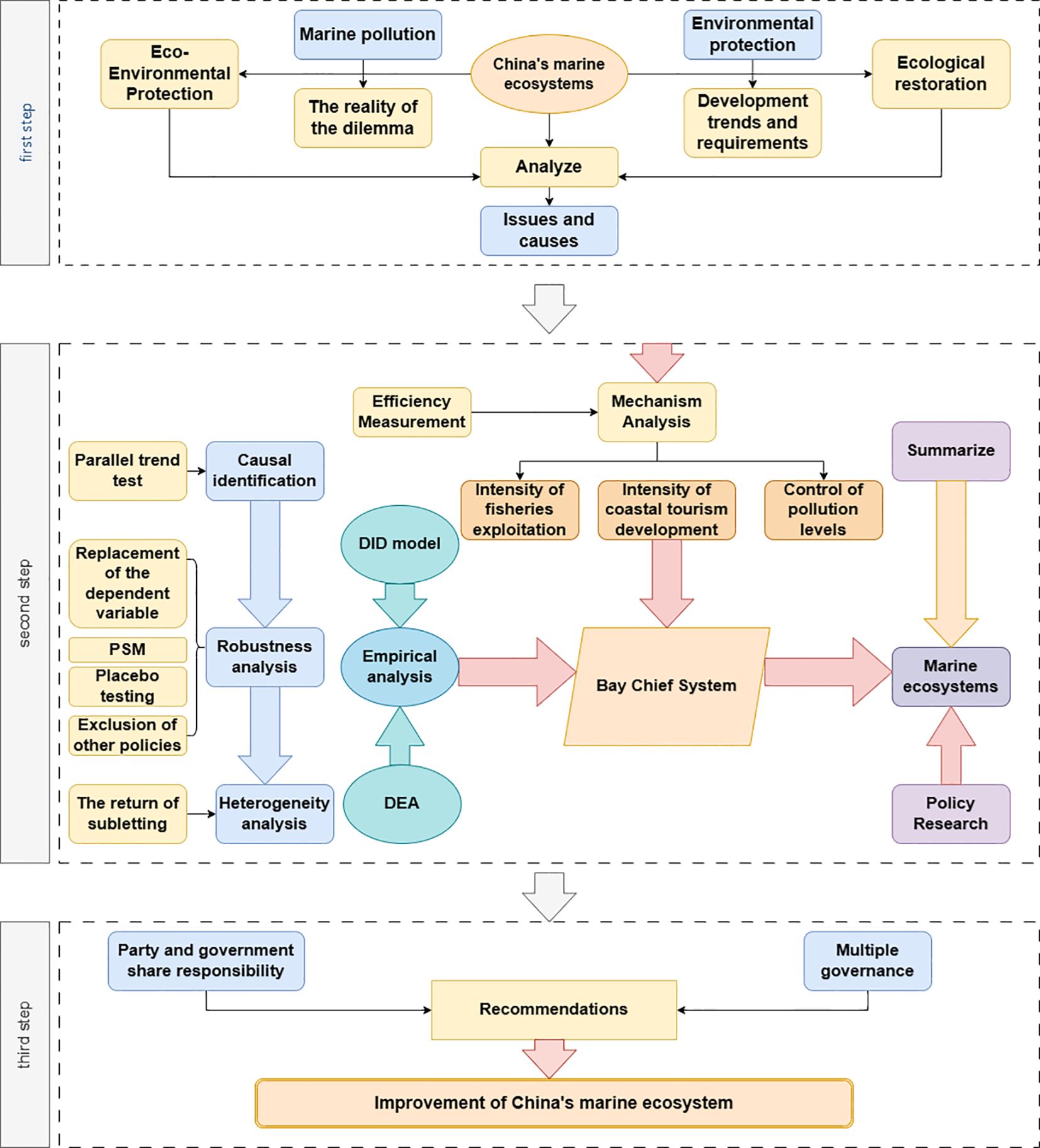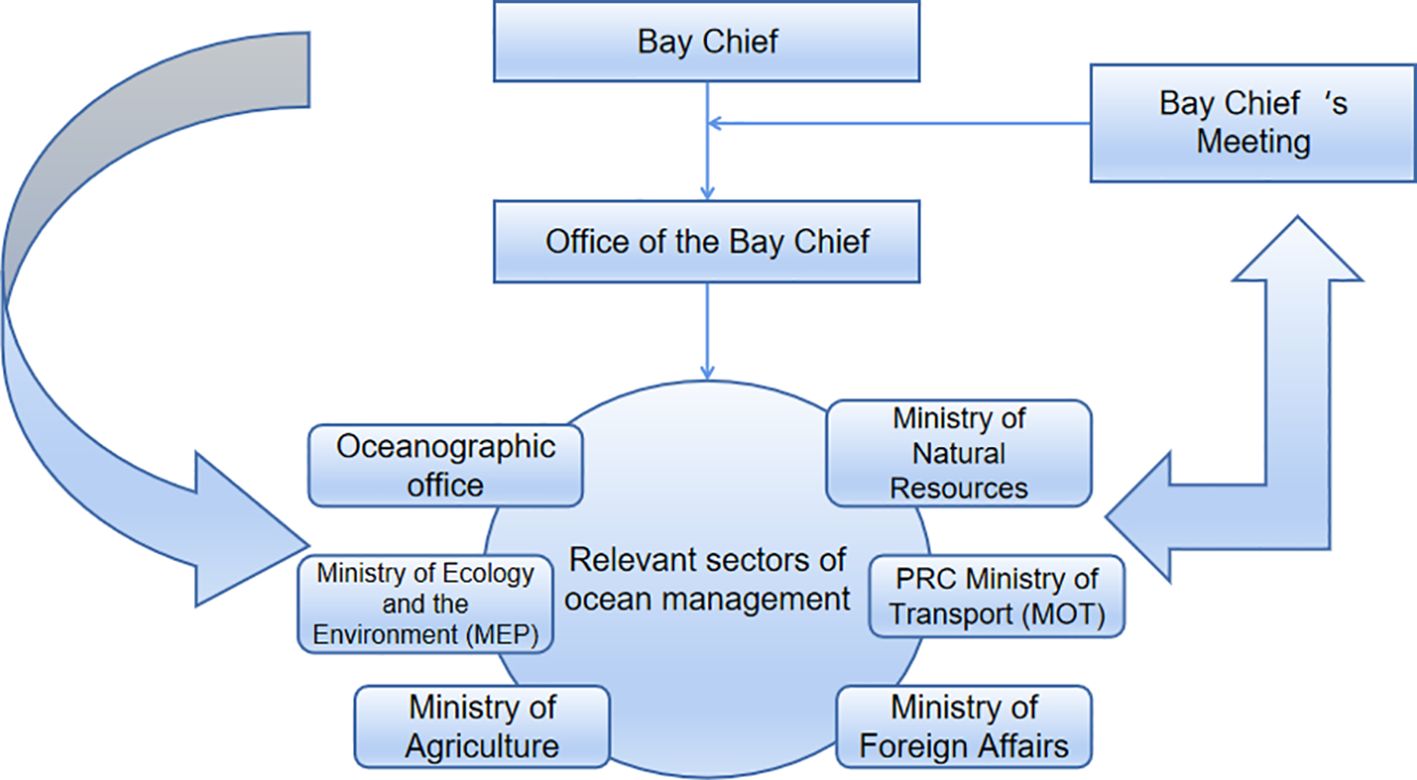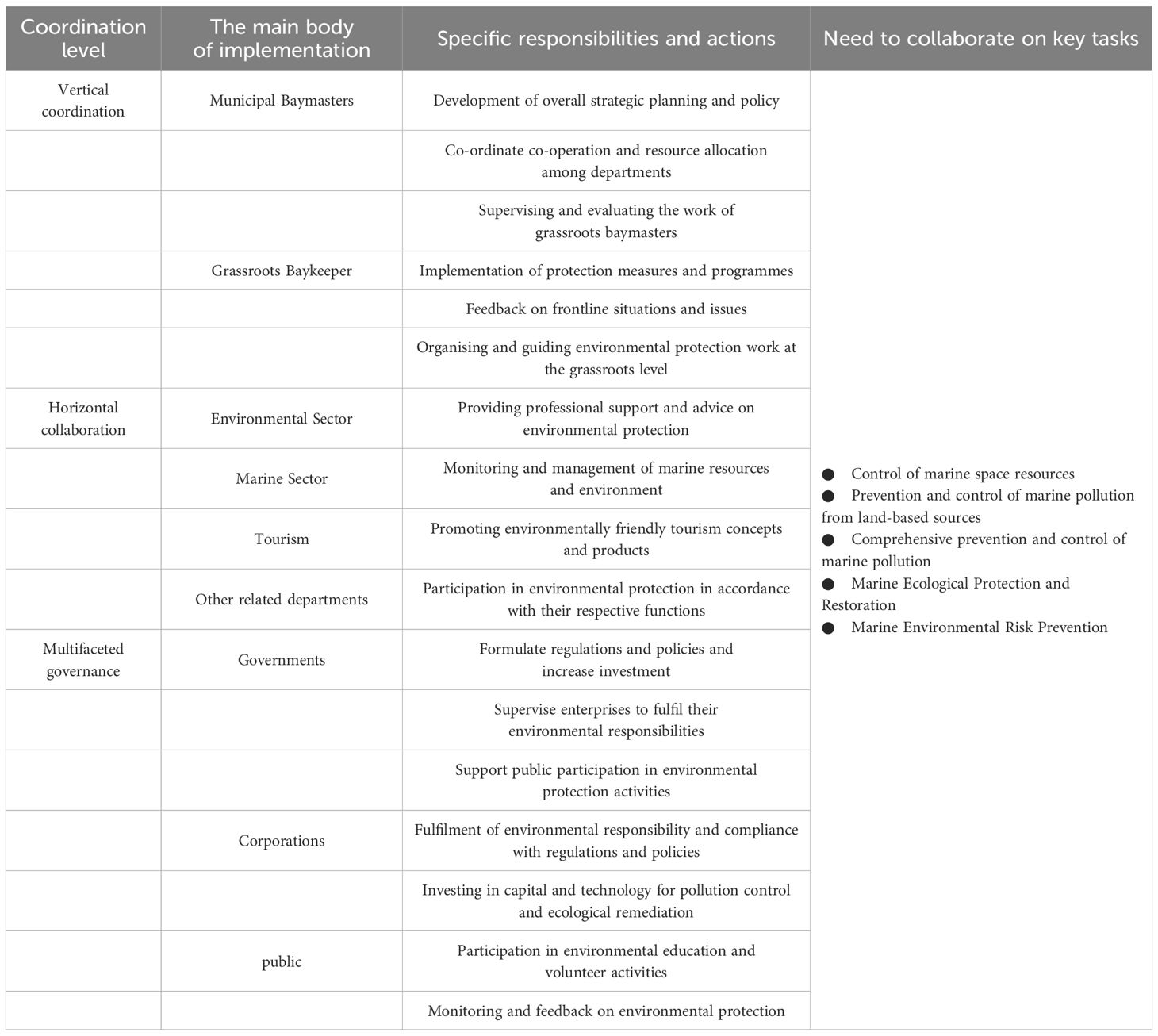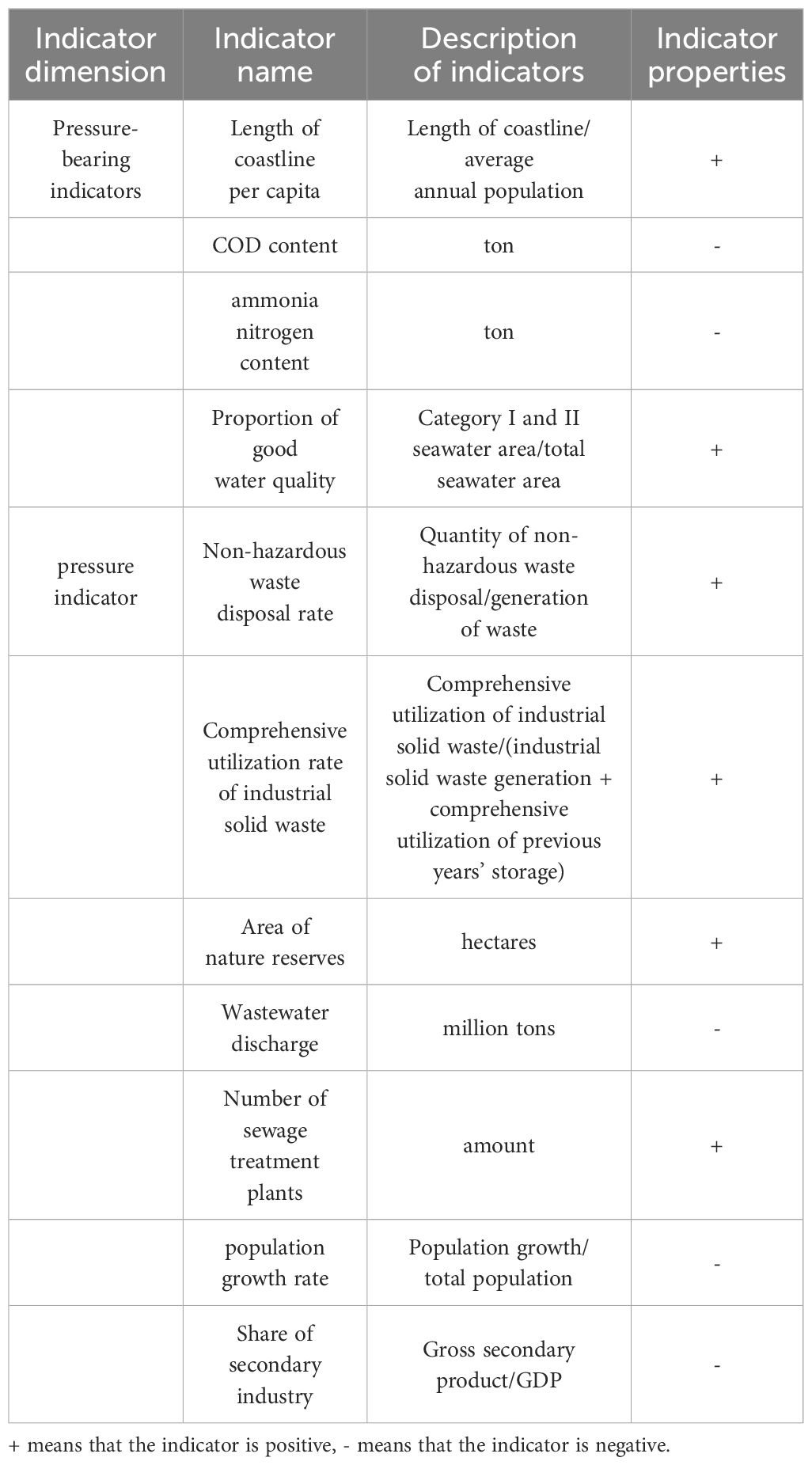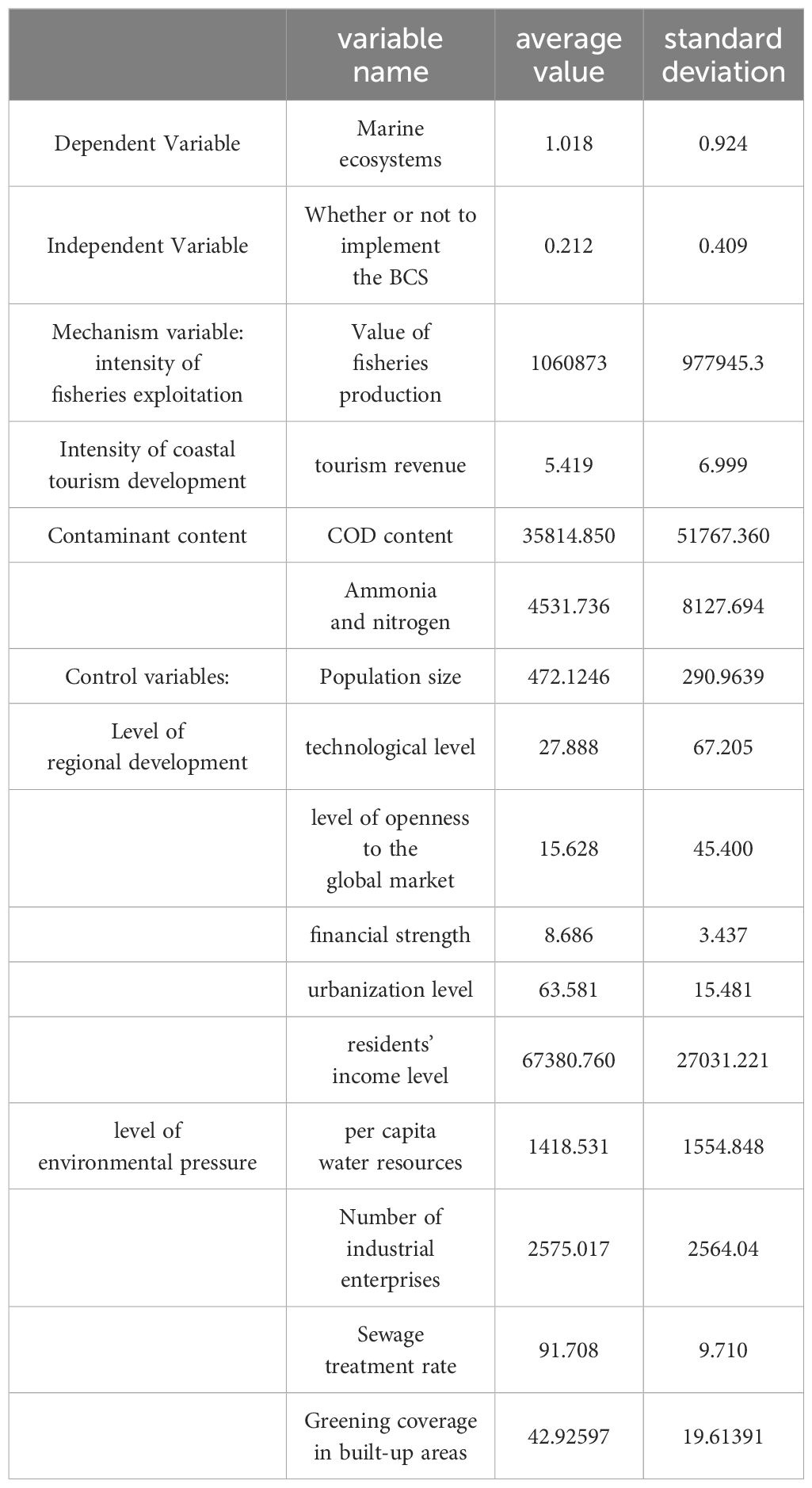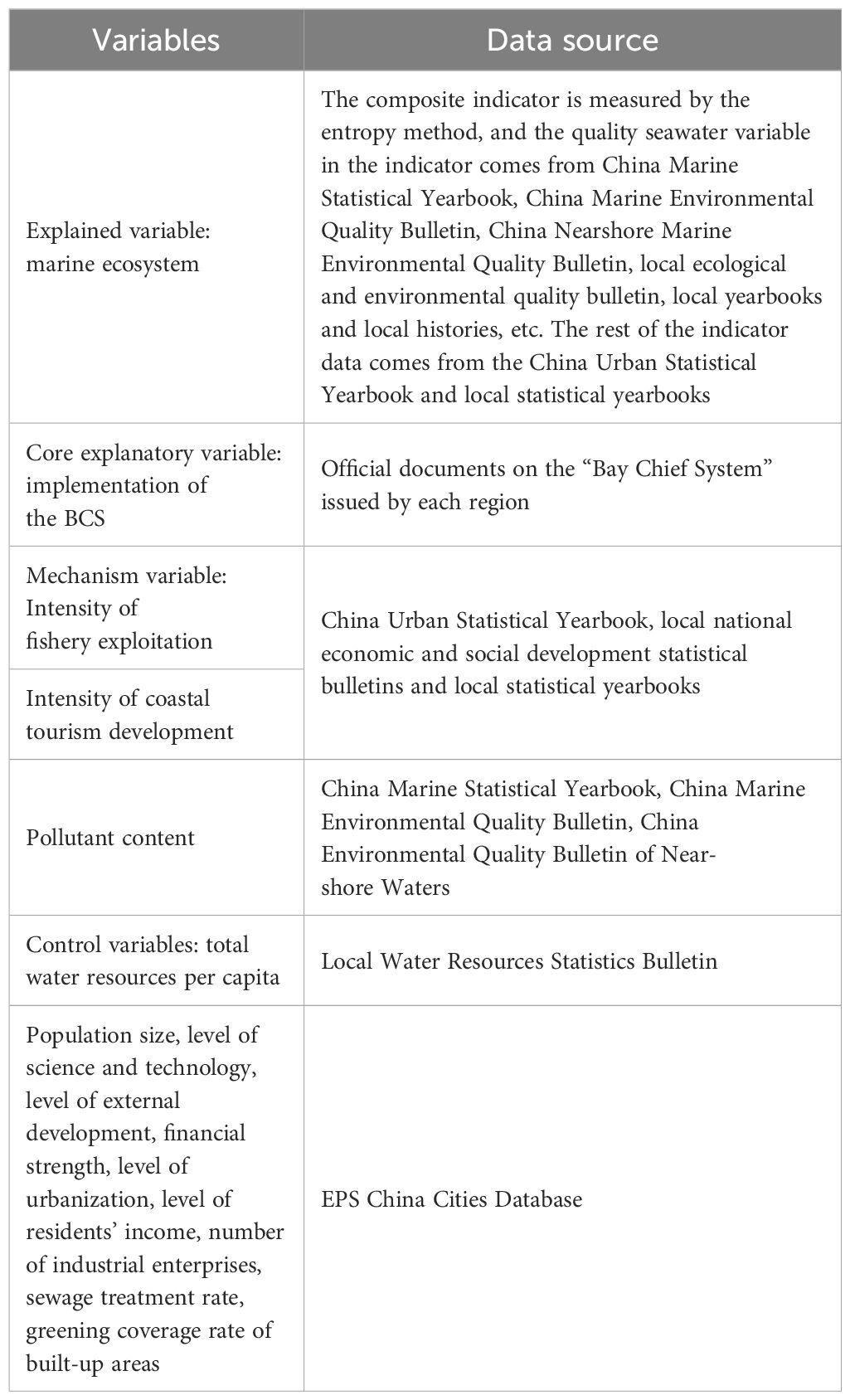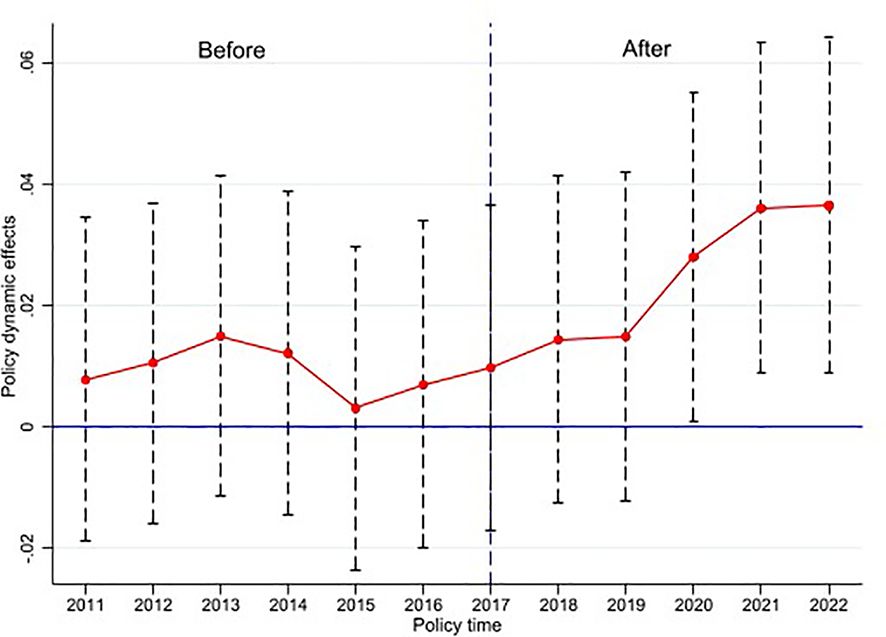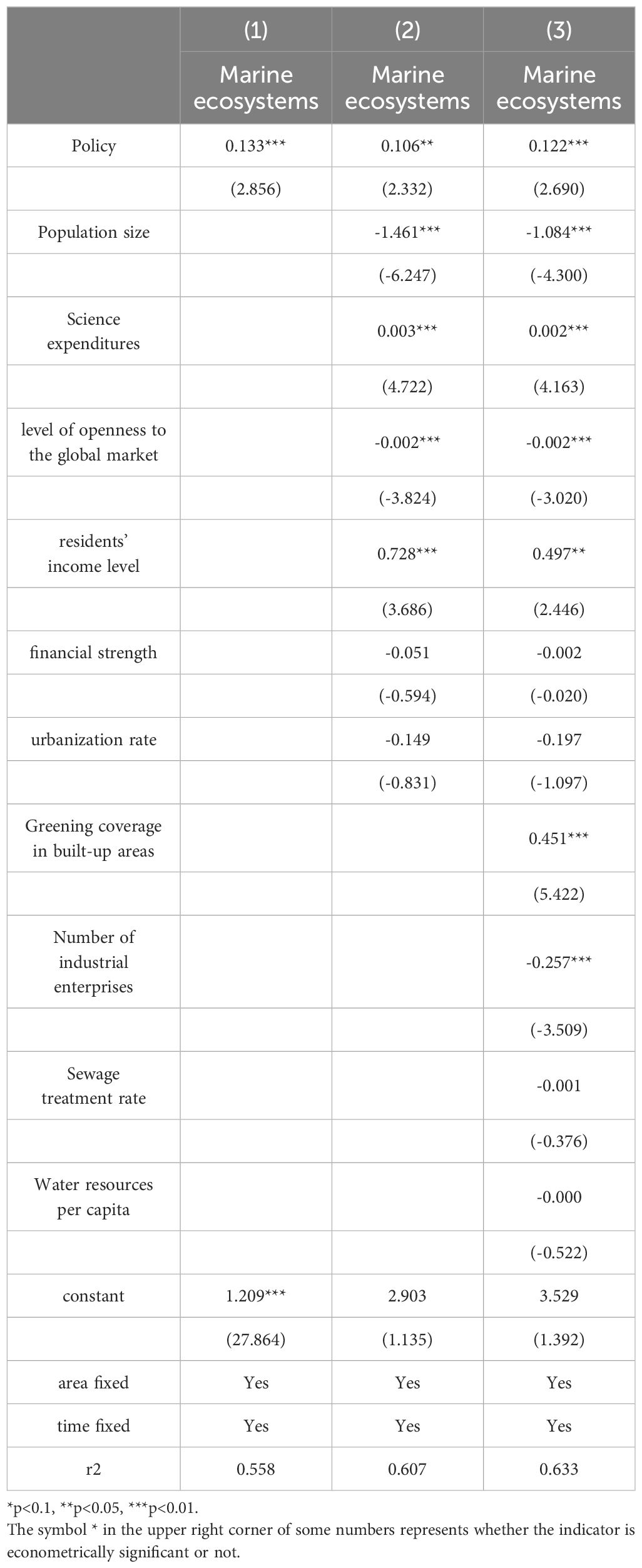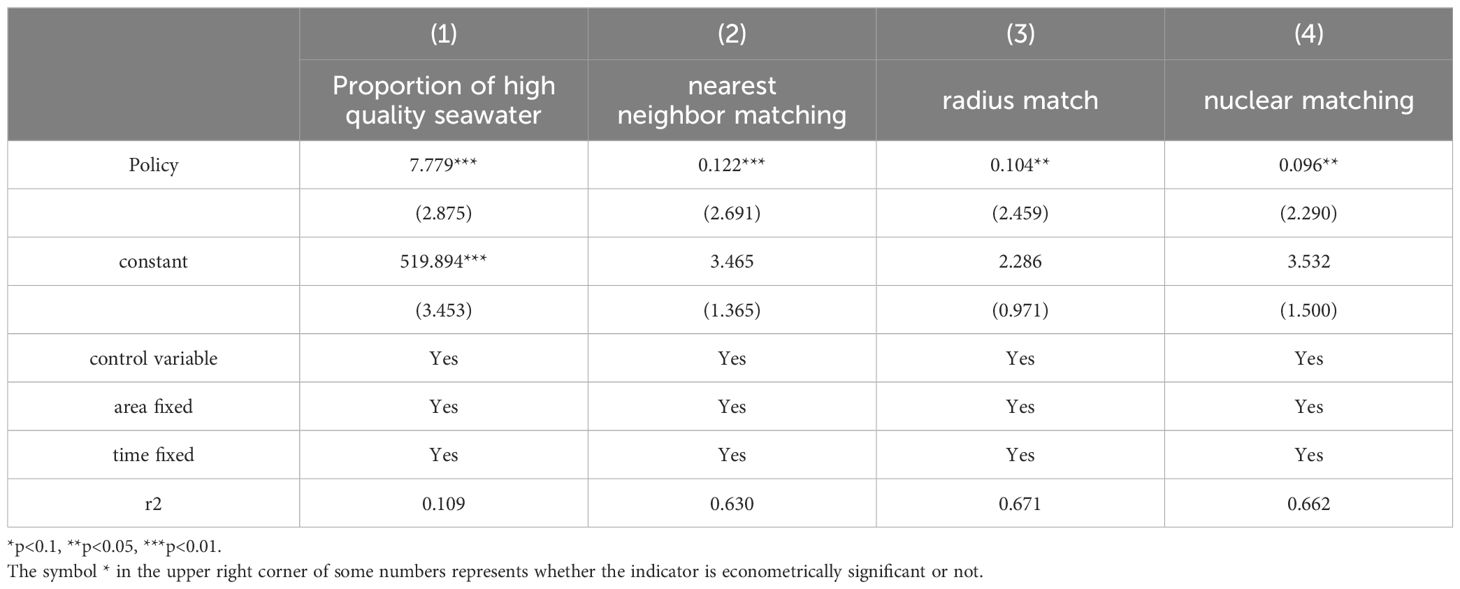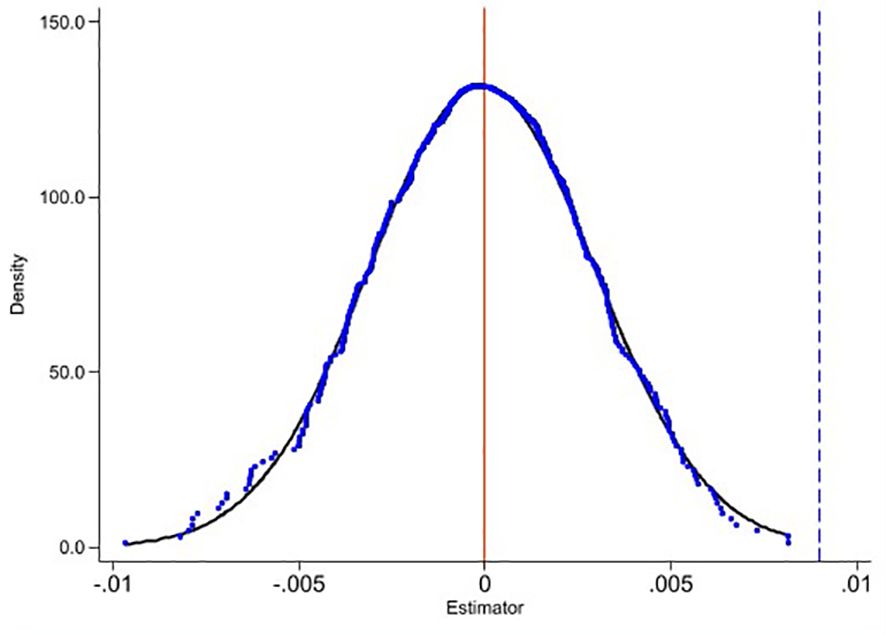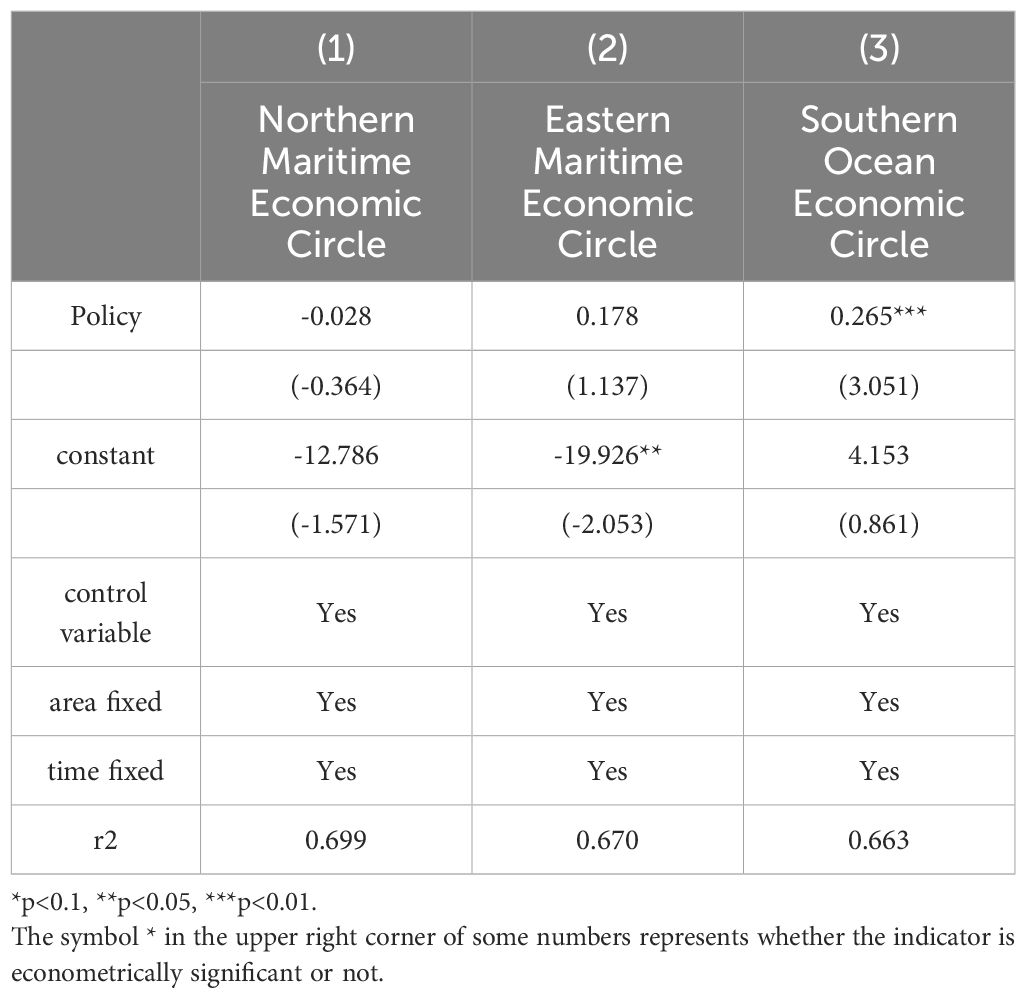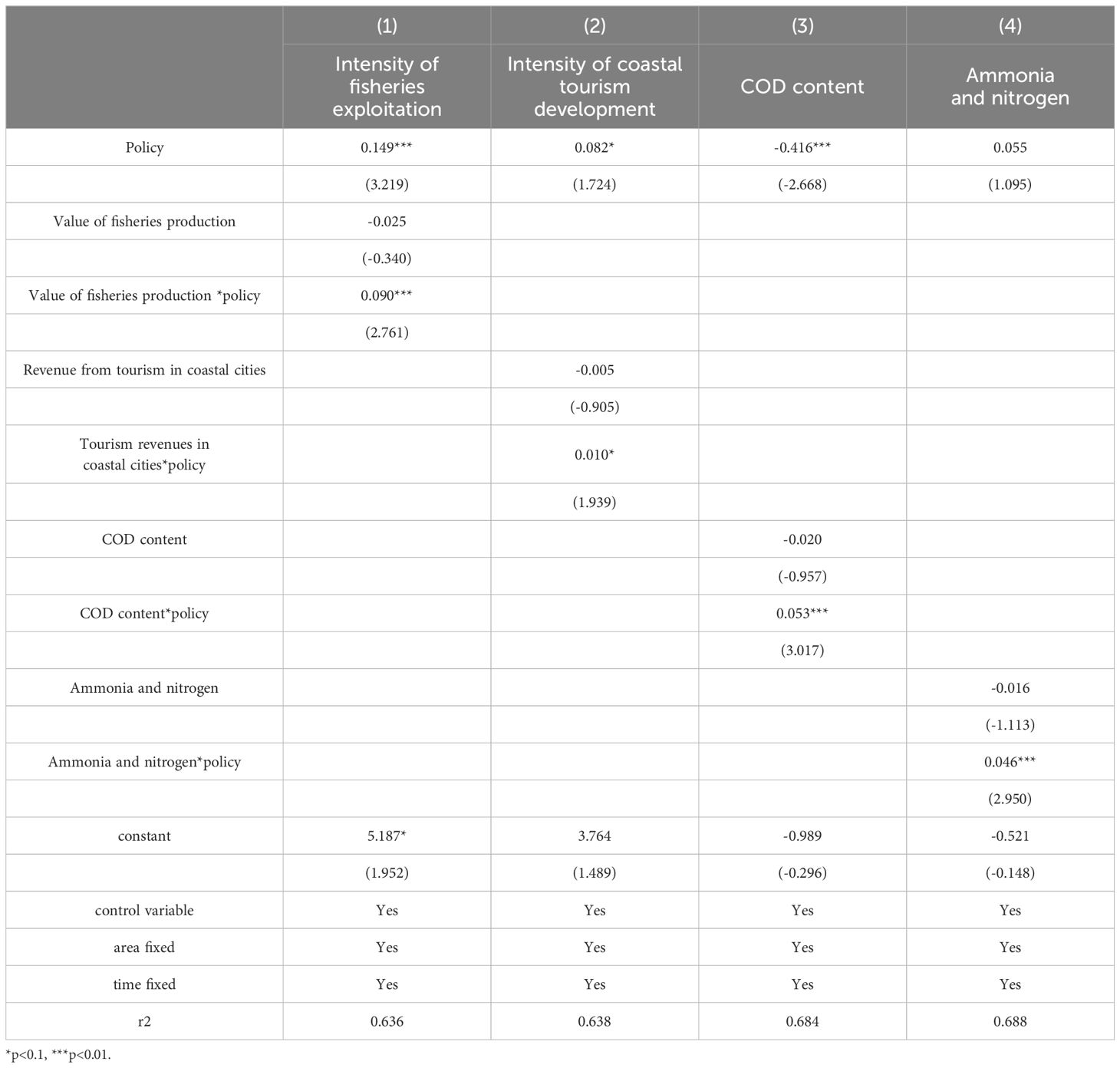- School of Management, Ocean University of China, Qingdao, China
Marine ecosystem governance is an important component of the goal of developing a strong maritime nation, as well as an urgent need to ensure national maritime security. The “Bay Chief System”(BCS) is a novel policy concept with Chinese roots that seeks to improve the marine ecological environment. In this paper, we take the coastal cities in China as an example and use the panel data of prefecture-level cities from 2010 to 2022 to analyse the impact of the Bay Chief System on the regional marine ecological environment by using a differences in-differences model. The baseline regression results reveal that the implementation of the Bay Chief System leads to a 0.122 percentage point improvement in marine ecosystems but it has yet to be linked to the River Chief System(RCS) to establish a systematic synergistic mechanism. Heterogeneity analysis reveals that the implementation of the Bay Chief System is more effective in coastal cities with smaller populations, a heavier proportion of secondary industries, and a geographic location closer to the South. The analysis of the impact mechanism indicates that the Bay Chief System mitigates the adverse effects of near-shore resource development on the marine ecological environment by regulating the intensity of fishery and coastal tourism development. Additionally, it optimizes water quality by substantially reducing pollutants like chemical oxygen demand (COD) and ammonia nitrogen (AN) in seawater, ultimately contributing to the protection of the marine ecological environment.
1 Introduction
The marine ecosystem is one of the most important and complex ecosystems on Earth and is of great significance to the survival and development of humankind. However, with the excessive exploitation and irrational utilization of marine resources by human beings, the marine ecological environment has been seriously damaged. According to the “2022 China Marine Ecological Environment Status Bulletin” published by the Ministry of Ecology and Environment in May 2023, most typical marine ecosystems are still in a sub-healthy state, some beaches are seriously polluted, and there are still issues such as irrational marine development and ongoing degradation of marine ecology. Marine ecological and environmental issues have become a major problem to which the government attaches great importance and the community is deeply concerned. The 20th Party Congress made the important strategic plan of “developing the marine economy, protecting the marine ecological environment, and accelerating the construction of a strong marine country”1. To effectively manage the marine ecological environment, in September 2017, the former State Oceanic Administration issued the “Guiding Opinions on Carrying out the Pilot Work of the “Bay Chief System”(BCS), and carried out the pilot work of the BCS in Zhejiang, Qinhuangdao, Qingdao, Lianyungang, and Haikou, and began to gradually expand the system to all coastal cities after 2018, with a view to improving the quality of the marine ecological environment. The introduction of the BCS as the latest form of marine ecological and environmental management with Chinese characteristics not only provides guidance for addressing China’s marine ecological challenges, exploring the establishment of a novel marine governance model, and systematically tackling marine ecological and environmental issues. Moreover, it is also an important manifestation of China’s participation in the world’s marine ecological and environmental governance, showcasing Chinese wisdom in the preservation of the world’s marine ecosystem. Therefore, it is crucial to elucidate the influence of the BCS on the marine ecological environment, which is a governance model by considering both the river and the sea and through coordinated governance.
2 Literature review
Marine ecosystem governance is a multifaceted responsibility involving numerous sectors and geographic areas (Yang et al., 2017; Roberts et al., 2021). Due to the public nature of the environment and the mobility of marine pollution, externalities, and free-rider issues often arise, resulting in unclear and shifting responsibilities. Additionally, the primary governing body in the previous model was the government, and management behaviours were administrative. This authoritative mode of environmental governance, which relies solely on government power, is prone to the disadvantages of weak trust, poor information, and insufficient coordination between polluting enterprises and the government, making it difficult to effectively solve marine ecological problems (Han and Feng, 2020; Liu et al., 2012). The escalating exploitation of marine resources, coupled with the expanding diversity of interests and the intricate relationships among stakeholders, renders the traditional government-led environmental governance approach inadequate for socio-economic development. How to solve the problem of interdependence and conflict caused by complicated governance entities and numerous subjects of interest is more important (Wang and He, 2004; Chu and Zhu, 2016; Vince et al., 2017). With the emergence of collaborative governance theory, pluralistic collaborative governance proves to be more effective in addressing environmental governance issues when compared to the government’s approach of single-aspect governance (Huitema et al., 2009; Widmer et al., 2019). The various subjects involved in pluralistic governance encompass the government, enterprises, civil society organizations, the general public, international organizations, and others (Quan, 2017). The roles played by these subjects differ based on their position in environmental governance (Huang, 2014). This paper takes the evolution of China’s ocean governance policy as an example to visualise the embodiment of the concept of pluralistic and synergistic governance in it, as shown in Table 1.
As can be seen from Table 1, over time, the governance approach has evolved from a single legal instrument to comprehensive management and systematic governance; the governance perspective has expanded from environmental protection to comprehensive marine management; and the main body of governance has gradually evolved from government-led to multi-dimensional and shared governance. These changes have contributed to the progress and improvement of China’s marine ecological and environmental governance. As shown in Figure 1, multiple actors play their roles according to their respective roles and work together to promote environmental governance, which helps to create a win-win situation. Therefore, in order to effectively manage the marine environment and achieve sustainable development, it is crucial to establish a marine environmental governance model with clear responsibilities and rights and multiple co-governance (Abe et al., 2016; Morrison et al., 2019; Ning and Mao, 2017).
The implementation of the BCS is a combination and innovation of the detailed responsibilities and the participation model of multiple actors. In Western countries, there is no mention of BCS or RCS about water environment governance. However, it is widely acknowledged that effective governance requires multiple participatory approaches, including the establishment of a synergistic mechanism among local governments, improvement of the government’s information disclosure system, and expansion of channels for social organizations and public supervision (Eriksson et al., 2015). The BCS in China is derived from the River Chief System(RCS) which was initially enforced by the Wuxi municipal government in 2007 following a water supply crisis resulting from a cyanobacteria epidemic in Lake Taihu. This successful approach to water environmental governance has become a benchmark for Chinese policy innovation, drawing attention to the RCS as a focal point of research in environmental protection and pollution governance. Studies have demonstrated that the implementation of the RCS has led to significant reductions in various water quality indicators, including dissolved oxygen (Shen and Jing, 2018), chemical oxygen demand (She et al., 2019), acidity and alkalinity, and ammonia nitrogen (Wang and Sun, 2020; Cheng et al., 2022). Moreover, it has also contributed to enhancing the quality of economic growth in Chinese cities (Wang and Sun, 2020; Cheng et al., 2022). However, the RCS has faced challenges such as excessive administrative reliance, difficulties in the assessment and accountability processes at the grassroots level (Zhu, 2013), uneven sharing of governance costs in subcontracted management (Li and H, 2017), lack of synergy between different levels and sectors, and the challenge of achieving effective collaboration between the government and society (Yan and Zeng, 2019). The gulf is interconnected with rivers and lakes and presents comparable management issues. Can BCS be as effective as RCS in solving marine ecosystem problems? Does it encounter analogous governance concerns? After reviewing the literature, current research on the BCS primarily concentrates on its generation and operation logic, analysis of implementation challenges, and optimization thinking (Li et al., 2019; Wang and Xin, 2019; Chen et al., 2020; Shen and Chen, 2022). Scholars have argued that the oceans, which are the main target of the bay chief system, are fundamental, large-scale, weak and external, resulting in “market failure” and the need for government intervention. However, the over-pursuit of GDP at the local level has led to the neglect of ecological environmental protection, while at the central level, the complex hierarchical structure of the government has led to information asymmetry and distortion, making it more difficult to implement the policy. The introduction of the Bay Chief System aims to address these issues in order to maintain national ecological, food and political security. In order to have a more comprehensive understanding of China’s water environment governance mechanism, especially the difference in governance effectiveness between the river chief system and the bay chief system, this paper further compares and analyses the key elements of the two systems, as shown in Table 2.
As can be seen from Table 2, the RCS and the BCS differ in a number of key dimensions, and these differences have a direct impact on the implementation effects and challenges faced by the two systems. The RCS has achieved remarkable results in inland river management by virtue of its wide coverage and mature implementation mechanism. However, for the bay area, the implementation of the BCS faces more challenges due to its more complex pollution sources and more cross-regional and cross-sectoral collaboration. In particular, the control of pollution in rivers entering the sea has become one of the key factors restricting the effectiveness of the BCS. Before we delve into the challenges faced by the BCS, it is worth noting that before and after the introduction of the BCS, the way of ocean governance has undergone significant changes. Before the implementation of the BCS, the relationship between the goals and responsibilities of ocean governance was unclear, the cost of governance was high, and it was difficult to achieve incentive compatibility. However, after the implementation of the BCS, governance costs have been reduced and the relationship between responsibility and rights improved by clarifying objectives and responsibilities, optimising assessment indicators, and enhancing the transparency of information disclosure, thus achieving partial incentive compatibility. In order to further promote the modernisation of ecological and environmental governance, it is necessary to establish incentive-compatible, commitment-monitoring and peer-to-peer synergistic mechanisms to carry out polycentric governance. In order to show the operation logic of the BCS more clearly this paper draws Figure 2, in order to provide a useful reference for the subsequent research.
Theoretical analyses prevail, yet empirical studies are lacking. There is a dearth of research on the impact of the BCS with only one evaluation of its governance effect in a single coastal province (Chen and Tang, 2022). Thus, the empirical evidence is insufficient to establish the causal relationship between the BCS and the marine ecosystem.
The issue of the marine ecological environment has garnered considerable interest from all sectors of society. Academics have conducted extensive research on the marine ecological environment and its governance, and the current findings have a significant illuminating effect on the marine ecological environment. To further illustrate this point, this paper collates key ecological and environmental issues mentioned by different countries or sectors. These issues not only reflect general concerns about marine ecosystems at the global level, but also demonstrate the diversity of perspectives and response strategies to address them, as shown in Table 3.
As can be seen from Table 3, in terms of marine ecological environment governance, the actions and governance programs of various countries have fully affirmed the positive effects of the marine environment governance model of joint participation of multiple subjects on the marine ecological environment, but there is little literature that explores in depth the effect of the synergistic policy of local governmental responsibility on the governance of the marine ecological environment under the micro perspective.
On this basis, this paper carries out the following expansion: on the theoretical level, it describes the principles and the impact mechanism of the BCS. In the empirical analysis, the research object is 54 coastal cities in China, and the panel data of Chinese prefecture-level cities from 2010 to 2022 are selected, so that the research scale is expanded from the provincial level to the municipal level, and the impact of the BCS on the marine ecological environment is examined through the hand-organized data of the implementation of the BCS and the more microscopic and informative data on the water quality. A double-difference two-way fixed-effects model is used to eliminate the confounding effects of non-spatial and temporal unobservable factors, to more accurately capture the differential impacts of the BCS, and to improve the reliability of the conclusions after a large number of robustness tests. Finally, an empirical test of the impact mechanism is conducted to provide stronger empirical evidence for the theoretical reasoning, and to provide a scientific basis for further improving the BCS and the marine ecological environment in the future. The specific flow of the study is shown in Figure 3.
3 Policy context and theoretical framework
3.1 Policy background
The BCS, China’s innovative system for governing the sea and the bay, was not born out of thin air but rather is rooted in the successful experience of China’s River Chief System(RCS) and, like the RCS, is embedded in the established environmental law and environmental administrative management system.
As early as 2014, when the Environmental Protection Law was amended, it was stipulated that local governments were required to assume environmental responsibility. For example, article 28 stipulates that “local people’s governments at all levels shall, in accordance with environmental protection objectives and governance tasks, take effective measures to improve environmental quality”. In 2016, Xiangshan County, Zhejiang Province, took the lead in implementing the BCS.2 Given the bottom-up practical exploration, to further explore the protection and governance model of near-shore sea areas and bays, in 2017, the State Oceanic Administration issued the “Guiding Opinions on Carrying out the Pilot Work of the Bay Chief System” (Guo Hai Fa [2017] No. 14) to formally implement the BCS in the form of mandatory regulations. The 2018 report on law enforcement inspection of the Marine Environmental Protection Law of the People’s Republic of China suggests hastening the creation of the BCS. In the same year, the National Development and Reform Commission, the Ministry of Ecology and Environment, and the Ministry of Natural Resources collaboratively issued the Bohai Sea Comprehensive Treatment and Battle Action Plan. The plan proposed the establishment and implementation of the BCS in three provinces and one city around the Bohai Sea, including Liaodong Bay, Bohai Bay, and Laizhou Bay. Since then, Coastal areas have implemented the BCS, which consists of a four-tier structure. This mechanism promotes coordinated operations of the bay chief and emphasizes the utilization of information technology to achieve refinement, normalization, and grid governance. As of 2023, the BCS has been implemented in all coastal provincial administrative regions across the country. In addition, during the implementation of the BCS, some regions have also simultaneously explored similar systems such as the Beach Chief System and the Island Chief System, greatly expanding the coverage of this system. With the gradual introduction of the BCS, the chronic problem of marine ecological protection, which was not practically grasped in the past, is gradually being loosened.
3.2 Theoretical framework
The BCS is a system that assigns top leaders of local governments, at all levels including provincial, municipal, county, and commune leaders, to act as bay chiefs for the bays under their jurisdiction. First, the BCS addresses the issue of externalities and free-riding on environmental pollution by implementing individual responsibility and defining each bay chief’s governed area. This is achieved through the target responsibility system and administrative accountability, which help prevent unclear responsibilities and shirking of duties, as well as gaming between the central and local governments and among local authorities (Li, 2018). The BCS links bay governance with government performance appraisal and enforces rewards and punishments based on evaluation results, compelling local government officials to take governance actions. This increases policy attention and prioritization of marine environmental governance within the party-government system and changes the traditional emphasis on the economy at the expense of ecological and environmental governance (Zhou and Xiong, 2017). Second, the BCS is structured into four tiers of “bay chiefs” which include provinces, cities, counties, and communes. Each tier has a bay chief’s office allocated. The offices are responsible for coordinating and transferring instructions from higher-level and local bay chiefs. Additionally, they inspect, assess, and evaluate the work of lower-level bay chiefs. They establish a communication mechanism between upper and lower levels to surpass information barriers, alleviate interdepartmental conflicts, and ensure cross-departmental cooperation. Finally, local authorities will regulate the polluting conduct of corporations, urge them to shoulder the primary responsibility for reducing pollution, and enhance accessibility by publishing basic bay information, the contact of the bay chiefs, and a reporting hotline, thus enabling the public to participate in governance and oversight, fostering synergistic governance among the government, enterprises, and the public. The specific organization chart is shown in Figure 4.
In summary, the BCS has the following advantages: first, it clarifies the responsibilities of all levels of government and avoids the problem of unclear responsibilities and powers; second, through the participation of multiple actors, it can gather more resources and wisdom to jointly deal with marine ecological and environmental problems; and lastly, the refined management of the BCS can help to ensure that the various protection measures are effectively implemented. In order to visualize the specific operation mechanism of the bay manager system at the grassroots level, Table 4 was drawn.
Accordingly, hypothesis H1 is proposed: the BCS can improve the marine ecological environment by clarifying the main parties responsible for authority and responsibility, implementing supervision and evaluation, strengthening horizontal and vertical coordination, and integrating multiple governance.
Human economic development is the leading cause of marine contamination. It is estimated that 80% of the pollution load in the marine environment comes from industry, agriculture, and other land-based activities (Huitema et al., 2009). Litter and pollution from industry is considered the most important marine threat, followed by fisheries and agriculture (Gkargkavouzi et al., 2020). Industry pollutes by releasing wastewater and waste that contain chemical pollutants into the ocean during production (Mu et al., 2023). This results in harmful substances accumulating in seawater, causing harm to marine ecosystems and organisms. This is especially true in cities with a high concentration of industrial activity where marine pollution is more severe. China, as a vast country, exhibits varying degrees of environmental damage across its seas due to differing levels of natural and socio-economic development. On the one hand, natural conditions such as ocean currents, climate, and geographic location affect the ability of pollutants to spread and dilute, as well as the ability of marine ecosystems to recover. On the other hand, differences in urban population size and levels of socio-economic development can affect the pressure on the marine environment and the quantity of pollutants discharged by activities such as industry, agriculture, and urbanization.
Accordingly, hypothesis H2 is proposed: the effect of the BCS on the improvement of the marine ecological environment varies according to the degree of industrial development, population size, and the conditions of natural economic development of the region.
In addition to land-based industrial pollution, environmental pollution resulting from fishing activities and ocean tourism must also be strongly considered. Overfishing in aquatic environments can surpass the ecosystem’s carrying capacity, resulting in a depletion of marine biodiversity and a reduction in self-purification. Moreover, farmed fish release organic wastes, including feces, urine, and feed residues, which can cause eutrophication in adjacent water bodies if untreated. With the emphasis on leisure tourism, coastal tourism has experienced significant growth. However, driven by economic interests, some of its development has caused damage to the water and marine life (Guo et al., 2021). This is particularly evident during the peak tourism season, which generates substantial amounts of beach garbage and contributes to the deterioration of the coastal area’s ecological environment. According to the Chinese Seawater Quality Standard (GB 3097-1997), the primary pollutant of the marine environment is COD, Ammonia nitrogen, and heavy metals exceeding seawater quality standards. Land-based and marine environmental monitoring focuses on these types of pollutants, and local governments primarily address COD content, ammonia nitrogen, and heavy metals in developing governance programs (Xu, 2014).
Accordingly, hypothesis H3 is proposed: the BCS manages the marine ecological environment by adjusting the intensity of fishery development and coastal tourism development, and the various management measures can reduce the COD and ammonia nitrogen content in seawater and realize the improvement of the marine ecological environment.
4 Method and data
4.1 Empirical model
4.1.1 Parallel trend test
The basic premise of the DID approach is the parallel trend assumption. Namely, in the absence of policy shocks to the treatment group (counterfactual), there should be no systematic differences in the trends of variables in the treatment and control groups over time. This paper therefore constructs the following parallel trend test model:
The independent variable policyit × timeit are replaced by D. The superscripts indicate the advance or lag of the implementation of the BCS, and to prevent dummy traps, the eighth year before the implementation of the BCS in Equation 1 is excluded.
4.1.2 Benchmark modelling
Based on the assumptions, this paper adopts a double-difference model to take 54 coastal cities in China as research samples, with the period of 2010-2022, and the specific model settings are as follows:
where yit is the dependent variable indicating the level of marine ecosystem in city i in period t, and policyit is the independent variable indicating whether or not city i has implemented the BCS in year t, taking the value of 0 or 1. If the region has implemented the BCS, it takes the value of 1, otherwise it takes the value of 0. Xit is the control variable, vi is the area fixed effect, and ut is the time fixed effect. α1 is the relationship between the BCS and the local marine ecological environment, based on the previous analysis, this paper expects that the sign of α1 should be positive, and ϵit is the random perturbation term.
4.1.3 Moderating effects modelling
This paper discusses the mechanism of the BCS to improve the marine ecological environment through the moderating effect. The main idea of the moderating effect is that if the relationship between the dependent variable Y and the independent variable X is a function of the variable m, m is said to be the moderating variable. That is, the relationship between Y and X is affected by the third variable m. The independent variable, the control variable, m, and the interaction term between m and the independent variable will be selected and regressed together, and if the regression result of the coefficient of the interaction term is significant, it means that there is a moderating effect. Based on Equation 2, the implementation of BCS is combined with the mechanism variables to construct a moderating effect model as in Equation 3 for mechanism analysis.
Where chainit serves as the mechanism variable, and where the remaining variables remain constant as in the previous article. Additionally, in this paper, the mechanism variable is centralized.
4.2 Selection of variables
(1) Dependent variable: The marine ecological environment is a complex environmental system that integrates natural, economic, and social influences. This paper combines the existing studies (Miao et al., 2006; Tan, 2010; Zhang et al., 2020) and the main implementation content of the BCS to construct the marine ecological environment evaluation index system by using the entropy value method. In this paper, 12 indicators are selected from the perspective of pressure bearing and pressure exerting to construct the marine ecological environment evaluation index system. As shown in Table 5, where a "+" in the indicator attribute indicates that the indicator is a positive indicator and a "-" indicates that the indicator is a negative indicator.
(2) Dependent variable: The dependent variable of this paper is whether coastal municipalities have implemented the BCS. This paper manually organizes the implementation of the BCS in coastal cities from 2010 to 2022. To ensure the accuracy of the hand-curated data, the evolution data of the BCS was organized based on two channels and cross-checked. First, we conducted a thorough search of the official literature on the BCS issued by each region through Baidu online encyclopaedia. We then manually compiled and organized the relevant information about the implementation of the BCS in each city, along with the corresponding year of implementation. For instance, the implementation date of the BCS in Dalian City was obtained from the “Work Program of Bay Chief System in Dalian City”. Additionally, data concerning the deployment of the BCS in individual regions was collected by searching news reports with the keywords “Bay Chief System” (or “Bay Chief”) on the China Knowledge Network (CNN).
(3) Mechanism variables: This paper chooses fishery development intensity, coastal tourism development intensity, and seawater pollutant content as the mechanism variables in this paper. The intensity of fishery development is represented by the output value of fishery; the intensity of coastal tourism development is represented by the tourism income of the region in the same year; and the content of seawater pollutants is represented by the content of COD and ammonia nitrogen, which are logarithmized in the empirical analysis.
(4) Control variables: To accurately identify the relationship between the BCS and the marine ecological environment, this paper selects variables that impact the marine ecological environment as control variables, categorized into two groups. The first category denotes the region’s level of development across six indicators: population size, measured by the average annual population; science and technology level, determined by the government’s scientific expenditure; level of openness to the global market, measured by the total amount of imports and exports in each region; financial strength, quantified by the ratio of government financial revenue to local GDP; urbanization rate, defined by the rate of urbanization; and residents’ income level, determined by the average salary of local workers. The second category is the level of environmental pressure, with four indicators: per capita water resources, represented by the ratio of the current year’s total water resources to the average annual number of people; the number of industrial enterprises, represented by the number of business entities in the industrial sector generating an annual main income of £20 million or more; sewage treatment capacity, represented by the proportion of regions that treat sewage harmlessly; and the rate of green coverage in built-up areas, represented by the proportion of green areas to the total built-up area in cities. In this paper, six indicators, namely, population size, residents’ income level, financial strength, urbanization rate, number of industrial enterprises, and greening rate of built-up areas, are logarithmized. Table 6 clearly shows all the variables and the results of the descriptive statistics.
4.3 Data sources
Panel data from coastal cities between 2010 and 2022 were collected for this paper, except Sansha City due to significant missing data. As the majority of the sea area is shared between multiple cities and there are intersections within the sea area of each coastal city, direct seawater quality data is not readily available, requiring some generalization, calculation, and organization. Specific data sources are shown in Table 7. However, there is a slight amount of data missing from this paper, which has been filled in using linear interpolation.
5 Results
5.1 Ex ante test for parallel trends
The premise of using the double-difference method is to meet the parallel trend test. This study selects 2017 as the foundational year for the BCS pilot implementation, and 2010 as the baseline group, in order to prevent complete covariance issues. According to Equation 1, the results of the dynamic impact of the policy are obtained, and the coefficients of the interaction term between the implementation of the BCS in each coastal city and the year dummy variable are plotted in Figure 5, with 95 percent confidence intervals indicated by the dotted line.
From Figure 5, we can find that before the implementation of the BCS, China’s marine ecological environment index shows a general trend of upward and downward fluctuations followed by gradual growth. The impact coefficient confidence intervals all intersect at zero, indicating an absence of systematic variation in marine ecological quality among coastal cities prior to the introduction of the BCS. The parallel trend hypothesis test conducted in this paper supports this finding. However, the policy only exhibited statistical significance in its third year of implementation, implying a delayed effect.
5.2 Double difference method
Table 8 displays the correlation between the BCS and the marine ecosystem as estimated by Equation 2. Three regressions were conducted: the first without the control variable; the second with the control variable of regional development level only; and the third with controls for both regional development level and environmental stress levels. Both time and region were also controlled for. All three sets of results have passed the test of significance and displayed affirmative effects, demonstrating that the BCS can bring about enhancements to the marine ecological environment. This confirms hypothesis H1 of the research paper.
Taking the findings from column (3) as a case in point, it is evident that, among control variables, population size, degree of openness to the outside world, and the number of industrial enterprises have a noteworthy adverse impact on marine ecology. Cities with larger populations typically face heightened resource constraints, which incline them toward excessive exploitation of natural resources to fulfil the basic needs of their residents, ultimately leading to the degradation of the marine ecosystem. Greater openness to the world outside also results in more trade activities and industrial development, exacerbating the risk of marine pollution. Industrial firms often release significant amounts of wastewater and liquid waste. As the number of such companies grows, the risk of pollutant discharges entering the oceans also increases, leading to direct harm to marine life and ecosystems.
Scientific expenditure, residents’ income level, and the green coverage rate of built-up areas significantly positively impact the marine ecological environment. Scientific expenditure promotes progress in marine scientific research, offering technical support for the protection and governance of the marine ecological environment. A positive and significant correlation also exists between residents’ income levels and the marine ecological environment. As people’s material living standards improve, their consumption demands and habits will also shift. Once a certain threshold of consumption is reached, individuals will increasingly consider the impact of their choices upon the natural environment. This, in turn, promotes the rational development and sustainable use of natural resources. Green cover of built-up areas may positively impact marine ecology by regulating the water cycle, improving water quality, safeguarding biodiversity, regulating climate, and maintaining sediments.
5.3 Robustness tests
5.3.1 Substitution of dependent variable
High-quality seawater is crucial for maintaining a healthy marine ecosystem and promoting marine biodiversity. It also serves as an indicator of the marine ecosystem’s condition. To test the robustness of the baseline regression outcomes, this paper employs the proportion of high-quality seawater between 2010 and 2022 as a Dependent Variable. The regression outcomes are presented in column (1) of Table 9, and the regression results are positively significant and consistent with the benchmark regression results. This lends support to the robustness of the benchmark findings.
5.3.2 Propensity score matching test
To overcome the systematic differences between samples and eliminate the problem of sample self-selection bias as much as possible, this paper adopts propensity score matching to find matches for the experimental group in the control group for sample matching. Matching methods are used in the form of nearest neighbor matching, radius matching, and kernel matching, respectively. The estimation results in columns (2) (3) and (4) of Table 8 show that the estimation results of the model are positive and significant regardless of the matching method, which is consistent with the expected results and further proves the robustness of the study in this paper.
5.3.3 Placebo test
To avoid interference from random and policy factors on regression results, a placebo test is carried out using a fictitious treatment group. We randomly selected samples from the 54 coastal cities in the sample to serve as the fictitious treatment group for the BCS implementation and repeated the sampling process 1000 times. The distribution of coefficient values is displayed in Figure 6. Under the randomized treatment, the estimated coefficient values are distributed around 0, which passes the placebo test. This indicates that the BCS does have an impact on the marine ecosystem, and the estimation results in this paper are robust.
5.3.4 Consideration of other policy disturbances
From 2010 to 2022, the government placed significant emphasis on pollution reduction and ecological preservation of water and marine ecosystems. Due to the numerous pollution sources and their direct hazardous implications for urban and rural water security, inland river contamination has received prior attention within governmental initiatives. Pollution in marine ecology encompasses not only industrial and agricultural pollution in nearshore and offshore areas but also the pollution carried by numerous inland rivers into the sea. This aspect is crucial in affecting marine ecological environments. The RCS plays a crucial role in improving the marine ecosystem by controlling water quality in rivers entering the sea and reducing the amount of pollution carried upstream and downstream. Therefore, to realize the systematic governance of water pollution, some coastal areas in China have adopted the two systems in parallel, opening up a new mode of governance that integrates the land and sea and takes into account both the river and the sea. In this paper, the implementation of the RCS is included in the model for testing, excluding the potential impact of the RCS on the marine ecological environment, to more accurately assess the implementation effect of the BCS. Column 1 of Table 10 reveals that even after accounting for the interference of the RCS, the BCS still exerts a notable positive influence on the marine ecosystem. However, the effect of the RCS on the marine ecological environment is insignificant. On one hand, this verifies the robustness of the benchmark regression results mentioned earlier, while on the other hand, it highlights that the RCS has not had a significant impact on the governance of the marine ecological environment, nor has it established a strong, synergistic governance system with the BCS. This paper suggests that the possible reason is that the offices of the two belong to separate government departments with distinct jurisdictions. Ambiguities in defining and dividing responsibilities emerge due to the governance involving various departments and regions. Moreover, inadequate communication and information sharing between various government departments result in information asymmetry, inaccurate decision-making, and a lack of consistency and coordination.
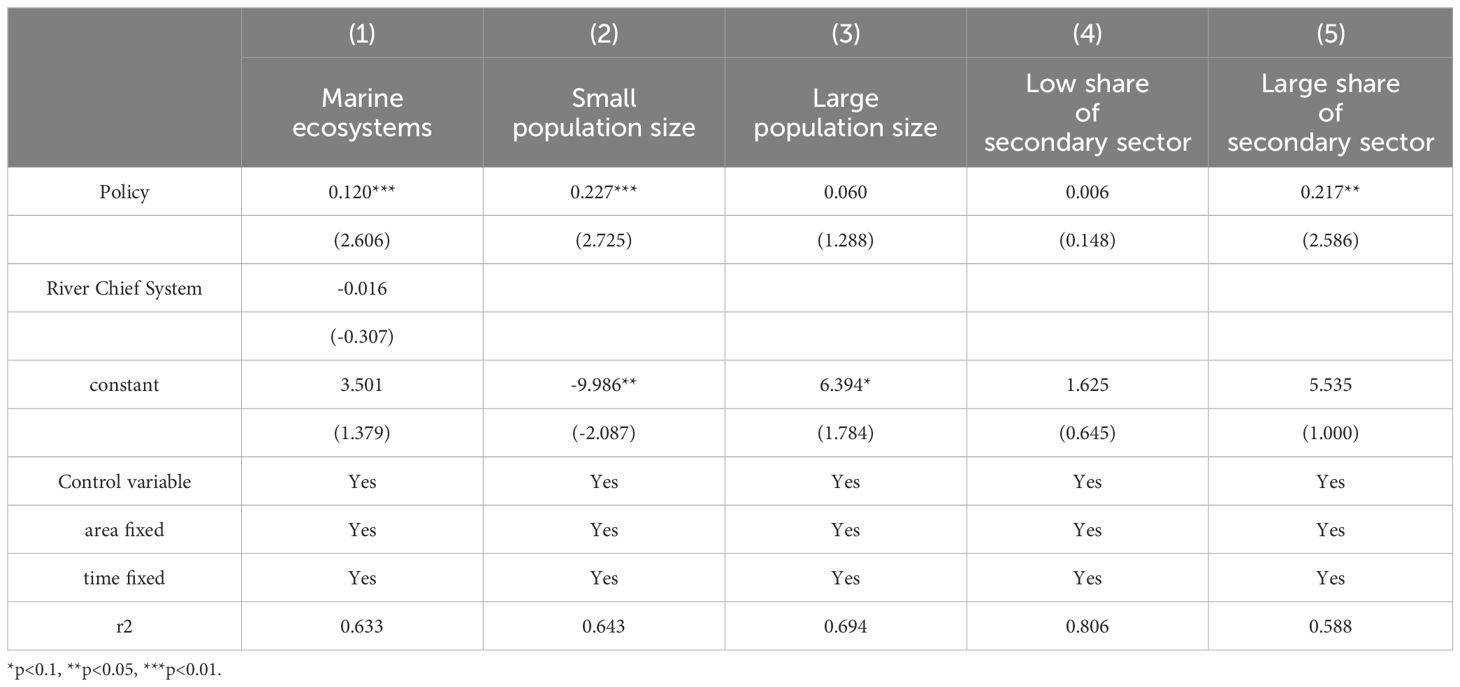
Table 10. Robustness tests:policy interference; Heterogeneity analysis: population size, degree of industrial development.
5.4 Heterogeneity analysis
5.4.1 Differences in population size
The enlargement of the population will result in an elevated request for resources. This demand will inevitably exceed the resources available, leading to their depletion and the resultant disruption of the equilibrium within the ecosystem. Additionally, a population surge will cause an increase in urbanization and industrialization, thereby contributing to the already mounting burden on the marine environment. The study divides the sample by population size, classifying it into large and small samples based on the median annual average population. This results in two groups for estimation, which are displayed in columns (2) and (3) of Table 10. Based on the regression findings, it is evident that the effectiveness of the BCS is higher in regions with lower populations, confirming the hypothesized H2.
5.4.2 Differences in the degree of industrial development
The paper categorizes the total sample areas into high and low secondary industry shares based on the median secondary industry share of each coastal city. The results are presented in Table 10 (4) and (5), indicating that the implementation of the BCS has a greater impact on the governance of the marine ecosystem in regions with a higher percentage of secondary industry. This result is in line with hypothesis H2.
5.4.3 Regional differences in physical geography
The division of physical geographic areas is based on the “14th Five-Year Plan” for the Development of the Marine Economy, which divides the 54 coastal cities into the Northern, Eastern, and Southern Marine Economic Rims. The Northern Ocean Economic Circle encompasses the Liaodong Peninsula, Bohai Bay, and the coastal areas of the Shandong Peninsula. The Eastern Ocean Economic Circle includes the coastal areas of the Yangtze River Delta, while the Southern Ocean Economic Circle comprises the coastal regions of Fujian, the Pearl River mouth and its surrounding areas, the Gulf of Tonkin, and Hainan Island. As demonstrated in Table 11 (1), (2), and (3), the effectiveness of governance in the Southern Ocean economic zone is significantly better than that in the Northern and Eastern Ocean economic zones, which is positive and significant, with an impact coefficient of 0.265 significantly higher than that of 0.178 in the Eastern region and -0.028 in the Northern region. Additionally, the trend shows a decline from the South to the North. The possible reason is that the southern coastal cities are primarily situated in subtropical or tropical regions, fostering a warm and humid climate, and promoting marine ecosystem biodiversity. The concentration of dissolved oxygen in seawater dwindles as the water temperature ascends. In the southern sector, the water temperature is higher, making the dissolved oxygen content inferior to that of the water in the northern region. Consequently, seawater quality is superior in the southern coastal region. Moreover, the southern coastal cities have experienced early economic development and possess stronger economic potential, enabling them to dedicate a greater amount of resources and funds towards the governance of the marine ecological environment.
5.5 Mechanism analysis
The findings presented in the preceding section provide empirical evidence that the implementation of the BCS has the potential to greatly enhance the marine ecological environment. A review of the implementation plan for the BCS, issued by several coastal cities, indicates that this system stresses the need to enhance the governance and surveillance of different near-shore development and usage activities. Furthermore, it offers targeted guidance for the fishing and tourism sectors. For instance, it is suggested that a regulatory system be established and enforced to manage pollutants stemming from fishing vessels, necessitating the implementation of an efficient marine sanitation system; improving the handling of seawater aquaculture waste; prohibiting the illegal dumping of waste; intensifying the monitoring of seawater-related activities encompassing sewage disposal, shoreline occupation, offshore fishing, seawater aquaculture, marine engineering and so forth, and carrying out lawful investigations and actions against any marine violations. Encourage the leaders of tourist attractions and other significant enterprises to act as civil bay chiefs, fulfilling their main responsibility for protecting the environment ecologically. Ensure the reduction of pollutants (COD, ammonia nitrogen) entering the sea by inspectors’ daily inspections of outfalls (sewage colour, smell), marine garbage (shoreline garbage, sea-drifting garbage, garbage from fishing ports and wharves, etc.), oil on the surface of the sea, and dumping of garbage, and by timely reporting of violations of the law and anomalies.
Accordingly, the following section further verifies the intrinsic mechanism of the BCS to improve the marine ecological environment and emphasizes the importance of green economic development.
In Table 12, columns (1)(2)(3)(4) represent the results of the moderating effects of fishery development intensity, coastal tourism development intensity, COD content and ammonia nitrogen content, respectively, and the regression results of the model show that fishery output value, tourism income of coastal cities, COD content and ammonia nitrogen content will have a negative impact on the marine ecological environment, but the regression coefficients of the interaction terms (policyit*chainit) of the four mechanism variables with the BCS are all positive and passed the significance test. This indicates that the implementation of the BCS has weakened the negative impact of fishery development and coastal tourism development on the marine ecological environment, significantly reduced the content of COD, and ammonia nitrogen in seawater, and served to protect the marine ecological environment, which verifies hypothesis H3.
6 Conclusions and policy recommendations
This paper selects the panel data of coastal cities from 2010 to 2022 and utilizes the double-difference model to study the relationship between the BCS and the marine ecological environment, and the main conclusions of this paper include the following aspects:
1. The results of the parallel trend test show that there was no significant difference between the experimental group and the control group before the implementation of the BCS, which is in line with the conditions of the model using the double-difference method. However, the BCS effect is not realized until after the third year, which indicates that the implementation effect of the BCS has a lag. The results of the benchmark regression prove that the BCS can improve the local marine ecological environment, while the conclusions of this paper still hold after the robustness tests of replacing the dependent variable, propensity matching scores, randomly constructing the dummy group and dummy time of the policy implementation, and considering the other policy interference. However, the empirical evidence from the regression of RCS interference also found that the RCS and BCS have not yet formed a close synergistic mechanism, and it is necessary to further explore how to strengthen the synergistic effect between the two policies to realize a better governance effect.
2. Heterogeneity analysis shows that, in the comparison of population size, the policy effect of the BCS is more effective in areas with smaller populations, and it is difficult to change the population size in a short period, which makes it particularly important to further raise people’s awareness of marine ecological protection; in the comparison of the difference in the degree of industrial development, the policy effect of the BCS is more obvious in areas with a higher proportion of secondary industry; in the natural geography, the effect of the policy implementation is only significant in the southern oceanic economic circle area, and the effect of the policy shows a trend of decreasing from the south to the north. The above differential results suggest that specific measures tailored to the characteristics of different geographical regions and industries will better utilize the effects of the policy.
3. The analysis of the mechanism shows that the BCS regulates the marine environment by regulating the intensity of fishery development and coastal tourism development, and improves the quality of the marine ecosystem by reducing the COD and ammonia nitrogen content of seawater. Therefore, emphasizing the impacts of near-coastal human activities on the marine environment and strengthening the related governance and monitoring are essential to ensure that the policy achieves long-term and sustainable effects.
Based on the above findings, the paper makes the following recommendations:
1. Strengthening the implementation and promotion of the BCS. As the BCS implementation has a lagging effect, the implementation and promotion of the BCS should be continued and strengthened. Government departments should gradually increase the proportion of environmental governance of bay in the overall work, and in the public disclosure of information, the focus of the work is reflected in the display, so that enterprises and the public intuitively feel the importance of the government’s work on Bay, and effectively raise the awareness of enterprises and the public on the protection of marine ecology and actively participate in coordinated governance.
2. Promote the establishment of a synergistic mechanism between the RCS and the BCS. At present, a close synergy mechanism between the RCS and the BCS has yet to be established. Governments at all levels should strengthen the overall planning and governance of river and bay ecosystems, unify the two from the top-level design, and then promote the establishment and improvement of the joint meeting system of bay chiefs and river chiefs and the information sharing system. Moreover, copy and report monitoring information promptly, realize the extensive coverage of the infrastructure of monitoring and assessment cross sections into the sea, report the monitoring results to the same level of river chiefs and bay chiefs, and find out the problems for joint discussion, to help form an ideal situation of river and sea co-management.
3. Regional governments should implement differentiated governance by local circumstances, taking into account their particular natural and geographical endowment characteristics and socioeconomic development conditions. Each region has unique natural resources, which should be combined with the actual circumstances of each bay to create a differentiated assessment system. With the aid of remote sensing monitoring, water quality monitoring, industrial characteristics analysis, and other methods, the overall consideration of all factors, accurately grasped the key factors affecting the ecological environment of the bay and targeted to address the problem of pollution in the sea.
4. Promoting modifications in the development of near-coastal resources and the economic development approach is essential. Intense development and utilization practices in coastal areas can have a detrimental effect in the bay. The key principle should be moderate and reasoned economic development. To ensure the sustainable utilization of fishery resources, it is important to establish reasonable catch limits, manage fishing periods, carefully select fishing gear, and protect no-fishing zones. Additionally, it is necessary to strengthen the management of aquaculture, promoting the reasonable use and treatment of feeds, as well as minimizing the discharge of wastewater and wastes in the process. When developing and utilizing tourism resources, it is essential to determine the scope and limitations of tourism development based on the environmental carrying capacity of coastal areas. Tourism development projects should undergo a strict examination and approval process. Further, implementing a tourism quota system during peak tourist season can help control the scale of tourism activities by restricting the number of tourists. To effectively improve the marine ecological environment, it is also critical to strengthen environmental education for both tourists and tourism practitioners.
Data availability statement
The original contributions presented in the study are included in the article/supplementary materials. Further inquiries can be directed to the corresponding author.
Author contributions
YC: Funding acquisition, Supervision, Writing – original draft, Writing – review & editing. YZ: Data curation, Formal analysis, Methodology, Software, Validation, Visualization, Writing – original draft, Writing – review & editing. YM: Writing – original draft, Writing – review & editing. ZS: Writing – original draft, Writing – review & editing. WY: Writing – original draft, Writing – review & editing.
Funding
The author(s) declare financial support was received for the research, authorship, and/or publication of this article. This work was supported by the National Natural Science Foundation of China (42176218); Shandong Province Key R&D Program (Soft Science)(2023RZA02025); Blue Think Tank Project of Qingdao National Laboratory of Ocean Science and Technology(BTT-B201712)
Conflict of interest
The authors declare that the research was conducted in the absence of any commercial or financial relationships that could be construed as a potential conflict of interest.
Publisher’s note
All claims expressed in this article are solely those of the authors and do not necessarily represent those of their affiliated organizations, or those of the publisher, the editors and the reviewers. Any product that may be evaluated in this article, or claim that may be made by its manufacturer, is not guaranteed or endorsed by the publisher.
Footnotes
- ^ Xi Jinping: Hold high the great banner of socialism with Chinese characteristics and unite for the comprehensive construction of a modern socialist country - Report on the 20th National Congress of the Communist Party of China (CPC) - Seekingalpha.com (http://www.qstheory.cn/yaowen/2022-10/25/c_1129079926.htm)
- ^ Comprehensively establishing and implementing the "beach manager system" to promote the sustainable development of marine fisheries (https://www.xiangshan.gov.cn/art/2017/9/20/art_1229045037_44448126.html)
References
Abe J., Brown B., Ajao E. A., Donkor S. (2016). Local to regional polycentric levels of governance of the Guinea Current Large Marine Ecosystem. Environ. Dev. 17, 287–295. doi: 10.1016/j.envdev.2015.06.006
Chen L. L., Zhan Y. X., Zeng Z. J., Chen J. M., He X. T. (2020). Cross-regional synergistic governance: The innovation of "bay manager system" under the perspective of Yangtze River Delta regional integration. Mar. Dev. Manage. 04), 12–16. doi: 10.20016/j.cnki.hykfygl.2020.04.002
Chen Z., Tang D. S. (2022). Evaluation study on the effectiveness of bay management in Jiangsu Province under the bay chief system. Hydropower Energy Sci. 04), 183–186+182.
Cheng C., Li W. T., Peng J. (2022). Regional environmental governance and the quality of economic growth in chinese cities: Empirical evidence from the implementation of the river chief system. Economic Issues 5, 99–110. doi: 10.16011/j.cnki.jjwt.2022.05.011
Chu J. S., Zhu Y. G. (2016). Research on the dilemma of China's ocean governance and its coping strategy. J. Ocean Univ. China (Social Sci. Edition) 05), 24–29. doi: 16497/j.cnki.1672-335x.2016.05.004
Eriksson M., Nutter J., Day S., Guttman H., James R., Quibell G. (2015). Challenges and commonalities in basin-wide water management. Aquat. Proc. 5, 44–57. doi: 10.1016/j.aqpro.2015.10.007
Gkargkavouzi A., Paraskevopoulos S., Matsiori S. (2020). Public perceptions of the marine environment and behavioral intentions to preserve it: The case of three coastal cities in Greece. Mar. Policy 111, 103727. doi: 10.1016/j.marpol.2019.103727
Guo S. P., Z X. B., G J., Z R. J., Xu, Haijiao (2021). A study on the impact of coastal tourism on the marine environment - A case study of Sanya. SAR Economy 10, 136–139.
Han L. X., Feng S. J. (2020). Research on regional marine ecological and environmental governance mechanism in the South China Sea: A perspective of global marine ecological and environmental governance. J. Hainan Univ. (Humanities Soc. Sci. Edition) 06), 18–26. doi: 10.15886/j.cnki.hnus.2020.06.003
Huang R. W. (2014). A preliminary study on global ocean governance. Ocean Dev. Manage. 31, 48–56. doi: 10.20016/j.cnki.hykfygl.2014.03.011
Huitema D., Mostert E., Egas W., Moellenkamp S., Pahl-Wostl C., Yalcin R. (2009). Adaptive water governance: Assessing the institutional prescriptions of adaptive (Co-)Management from a governance perspective and defining a research agenda. Ecol. Soc. 14, 26. doi: 10.5751/ES-02827-140126
Li Q. (2018). Research on the abatement effect of environmental decentralization under the perspective of river chief system. Ind. Economics Res. 3, 53–63. doi: 10.13269/j.cnki.ier.2018.03.005
Li Q., Zhang A. G., Qi Y., Yuan, Lei, Fu Y. B. (2019). Countermeasure suggestions for the comprehensive establishment and implementation of the bay chief system in China. World Environ. 03), 23–26.
Li Y. S., H Y. (2017). Exploration of the path of holistic governance of river basin ecological environment - based on the perspective of river chief system reform. Res. Socialism Chin. Characteristics 4, 73–77.
Liu L., Zhang B., Bi J. (2012). Reforming China’s multi-level environmental governance: Lessons from the 11th Five-Year Plan. Environ. Sci. Policy 21, 106–111. doi: 10.1016/j.envsci.2012.05.001
Miao L., Wang Y. G., Zhang Y. H., Wang Q. M. (2006). Research on the evaluation indicator system of marine ecological environment carrying capacity. Mar. Environ. Sci. 03), 75–77.
Morrison T. H., Adger W. N., Brown K., Lemos M. C., Huitema D., Phelps J., et al. (2019). The black box of power in polycentric environmental governance. Global Environ. Change 57, 101934. doi: 10.1016/j.gloenvcha.2019.101934
Mu L., Tan Z., Luo C., Qiao N. (2023). Exploring the contribution of the river chief system on controlling industrial water pollution under quasi-natural experimental conditions. Environ. Sci. pollut. Res. 30, 89415–89429. doi: 10.1007/s11356-023-28476-y
Ning L., Mao H. (2017). Analysis of the positioning of government, enterprise and public in marine environmental governance. Ocean Dev. Manage. 04), 13–20. doi: 10.20016/j.cnki.hykfygl.2017.04.002
Quan Y. B. (2017). Logical foundation and institutional supply of cross-regional governance of marine environment. China Administration 1, 19–23.
Roberts B. R., White M. P., Davison S. M. C., McMeel O., Eatock C., Kellett P., et al. (2021). Public preferences for policy intervention to protect public health from maritime activities: A 14 European country study. Global Environ. Change 71, 102397. doi: 10.1016/j.gloenvcha.2021.102397
She Y., Liu Y., Jiang L., Yuan H. (2019). Is China’s River Chief Policy effective? Evidence from a quasi-natural experiment in the Yangtze River Economic Belt, China. J. Cleaner Production 220, 919–930. doi: 10.1016/j.jclepro.2019.02.031
Shen K. R., Jing G. (2018). Policy effects of local government environmental governance in China: A study based on the evolution of the "river chief system. China Soc. Sci. 05), 92–115+206.
Shen Q. H., Chen Z. L. (2022). Implementation dilemma and rule of law optimization of the "bay length system" in the Yangtze River Delta region. Ocean Lake Marsh Bull. 01), 160–166. doi: 10.13984/j.cnki.cn37-1141.2022.01.020
Tan Y. Y. (2010). Research on marine resources, ecology and environmental carrying capacity and its application in Bohai Bay. Qingdao, China: Ocean University of China.
Vince J., Brierley E., Stevenson S., Dunstan P. (2017). Ocean governance in the South Pacific region: Progress and plans for action. Mar. Policy 79, 40–45. doi: 10.1016/j.marpol.2017.02.007
Wang L., Sun Z. Y. (2020). Research on the environmental and economic double dividend effect of the river chief system–a quasi-natural experiment based on the implementation of river chief system policy in the Yangtze River Economic Zone. Soft Sci. 11), 40–45. doi: 10.13956/j.ss.1001-8409.2020.11.07
Wang Q., He G. S. (2004). Policy options for marine environmental governance. Mar. Bull. 03), 73–80.
Wang Q., Xin A. N. (2019). The operation logic of "bay chief system" and related thoughts. Environ. Prot. 08), 31–33. doi: 10.14026/j.cnki.0253-9705.2019.08.008
Widmer A., Herzog L., Moser A., Ingold K. (2019). Multilevel water quality management in the international Rhine catchment area: How to establish social-ecological fit through collaborative governance. Ecol. Soc. 24 (3), 27. doi: 10.5751/ES-11087-240327
Xu H. (2014). Land and Sea Integration to Build a Beautiful Bohai Bay–Interview with Wang Zuwen, National People's Congress Deputy and President of Dalian Maritime University Vol. (03) (China Ship Inspection), 30–32.
Yan H. N., Zeng D. (2019). Dilemmas and reflections on the innovation of water environment governance under the river chief system - based on the perspective of collaborative governance. J. Beijing Administrative Coll. 2, 7–17. doi: 10.16365/j.cnki.11-4054/d.2019.02.002
Yang Z. J., Guo J. F., Wang H. L. (2017). Study on the realization path of modernization of China's marine ecological security governance. J. Ocean Univ. China (Social Sci. Edition) 06), 19–23. doi: 10.16497/j.cnki.1672-335x.2017.06.004
Zhang J., Ning L., Cao Y., Chun (2020). Evaluation of the environmental carrying capacity of marine resources based on entropy weight TOPSIS model–taking guangdong province as an example. Ecol. Economy 03), 162–167.
Zhou J., Xiong Y. (2017). The river chief system":How sustainable innovation is possible - A two-dimensional analysis based on policy text and reform practice. Jiangsu Soc. Sci. 04), 38–47. doi: 10.13858/j.cnki.cn32-1312/c.2017.04.006
Keywords: bay chief system, marine ecosystem, differences-in-differences, policy evaluation, ocean governance
Citation: Chen Y, Zhou Y, Ma Y, Sun Z and Yang W (2024) Can China’s ocean governance system improve the marine ecosystem? – Taking the “bay chief system” as an example. Front. Mar. Sci. 11:1361187. doi: 10.3389/fmars.2024.1361187
Received: 25 December 2023; Accepted: 19 July 2024;
Published: 30 August 2024.
Edited by:
Kum Fai Yuen, Nanyang Technological University, SingaporeReviewed by:
Yi-Che Shih, National Cheng Kung University, TaiwanQutu Jiang, The University of Hong Kong, Hong Kong SAR, China
Copyright © 2024 Chen, Zhou, Ma, Sun and Yang. This is an open-access article distributed under the terms of the Creative Commons Attribution License (CC BY). The use, distribution or reproduction in other forums is permitted, provided the original author(s) and the copyright owner(s) are credited and that the original publication in this journal is cited, in accordance with accepted academic practice. No use, distribution or reproduction is permitted which does not comply with these terms.
*Correspondence: Yusheng Chen, MjAxMDAxOUBvdWMuZWR1LmNu
 Yusheng Chen
Yusheng Chen Yongwei Zhou
Yongwei Zhou Weili Yang
Weili Yang